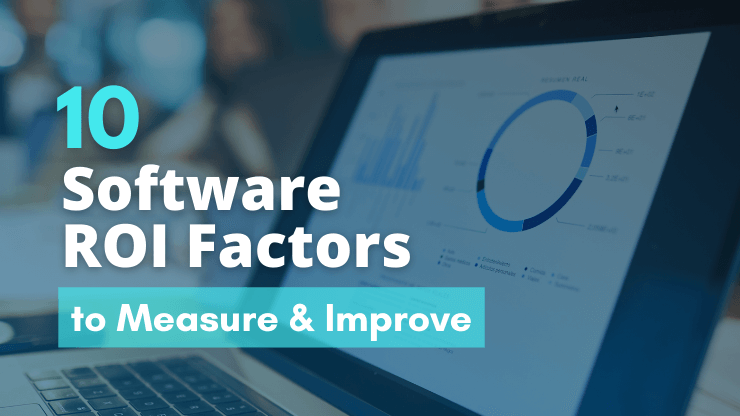Software investments have hige impacts on internal processes and in gaining competitive advantage over competitors. Business that outgrow their compoetitors are often better in monitoring and measuring software Return on Investment. Their software RIO factors a grounded in real impact on the business.
Having built many custom software solutions offer the past 15 years, in this article we share our first hand knowledge about software ROI factors. Lets get started!
What is software ROI?
Software ROI, or the Return on Investment, is an organization’s gain or benefit from implementing new software or technology. Mathematically speaking:

While the investment cost is simple to calculate or define, benefits or gains from software investment may vary from one business area to another. It may result in increased revenue, improved employee productivity, a rise in automation, or even higher cost optimization.
Let’s understand it through an example:
Benefit of Investment
If an e-retailer plans to implement a new e-commerce software, the benefits or gains can be referred to increase in orders or a drop in abandoned carts. Similarly, a brick-and-mortar retailer implementing a CRM application will calculate the ROI using a rise in employee satisfaction or a reduction in complaint resolution time.
Cost of Investment
You should include expenses like licensing, implementation, support, and maintenance from the cost perspective. Further, there can be additional costs like organizational change management costs. This will consist of transition cost, the cost to train your workforce, and the opportunity cost for diminished productivity.
While all these are important, an important aspect is why software Return on Investment is calculated. The short answer is to bring accountability. Whether CFOs try to bring expenses down or growth leaders try to increase revenue. These initiatives leverage technology, which comes at a cost. Calculating ROI for your software helps:
- Justify the investment into new technology.
- Quantify your ideas in front of relevant stakeholders or decision-makers.
- Attribute your goals or success to strategic steps like digital initiatives.
Calculating ROI for a software project
We know that software roi calculation of the money you stand to gain from an investment. However, all the factors to calculate the gain or estimate the actual cost is no easy task. Several aspects might not be visible or are too complex to quantify in terms of money.
For example, estimating time is not a straightforward process. Should you factor in the time saved due to a digital-enabled business process? And, what about the time lost during implementation?
Despite standard guidelines, three critical pointers will make your software Return on Investment calculation process resilient:
- Calculate ROI to a time period. This is because your ROI won’t be the same over time. It will be pretty low during the initial phase of adoption due to too much upfront investment, one-time set-up as capital expenditure, cost of training, and more. However, a few weeks or months down the line, the ROI will improve as the productivity increases or revenue starts kicking in.
- Calculate two versions of ROI estimates — pessimistic and optimistic. The former will assume the lowest reasonable gain and the highest reasonable cost. And the latter will have the highest possible yield with the lowest cost. This way, you’ll have a range of possibilities that will be easier to justify or sell in front of stakeholders.
- ROI for technology can be categorized as Anticipated ROI and Actual ROI. The former is performed at the time of making a business case. We consider estimated costs, revenues, and other assumptions to determine how much profit a project will generate. Actual ROI is calculated after the software has been running for a while. It uses final costs and revenues to determine how much profit a project produced compared to what was estimated.
Metrics to measure software ROI for software investments
How you assess ROI depends on your software. This article focuses on business process enterprise software, which improves internal procedures and optimizes team workflow.
End-user productivity
End-user productivity can swing both ways depending on how well you manage the change due to new software implementation. Though there is no direct formula, try to measure factors such as reducing the output or the amount of human intervention required.
For example, poor change management may result in disengaged employees and lower employee morale, leading to more stress and frustration. This may eventually cause some workers to become burnt out and quit. According to research by Gallup, an actively disengaged employee costs 34% of their salary to the organization. This means that a small business with 250 employees loses $3 million a year. That’s a lot of money!
On the other hand, improvements in performance standards can reduce costs. Typically, these costs are categorized as missing time, indirect labor, and direct labor. You must proactively manage all three cost categories and measure the changes in each to get an accurate picture of your ROI.
- For instance, blue-collar workforce management solutions like ERPs or WMS help clock unaccounted time. Such missing time costs the organizations in their payroll but never accounts for end-user productivity. Digital solutions help in reducing missing times by improving the time tracking workflow.
- Further, the software can help reduce the indirect labor — activities that don’t correspond to direct economic value. These are safety meetings, cleaning, maintenance, etc. Technology improves collaboration and tracking, thus reducing indirect labor costs.
- Lastly, direct labor is the work that creates economic value for your company, and this is what you get paid to do by your customers. One must understand that productivity improvements might translate directly to cost per unit savings or even the overall standard.
Employee experience
Tools contribute to a high-performing workplace or generate an uptick in employee engagement. Right software enables transformational and sustained changes within a workforce by:
- developing skills and competencies
- nurturing collaborations and effective communications
- aligning organizational goals with employees’ aspirations
As a result, organizations can adapt to change and empower their employees. Investing in the right employee experience technology is a giant leap forward as it directly impacts your financial performance.
For example, here are a few ways to improve the employee experience:
- A digital workplace can help support the flexible and hybrid working culture here to stay for a while (maybe permanently).
- Digital tools now make it seamless to gain employee feedback through multiple channels. It has become increasingly important, mainly as the pandemic has introduced new and diverse pressures.
- Employees can also benefit from the clarity of expectations: from the initial job application, the first day on the job, to the ongoing performance reviews. Organizations can provide a personalized dashboard for each employee using the right platform.
- The right technology can simplify complex business processes, automate mundane tasks and integrate multiple new system to provide a 360-degree view. This helps reduce manual errors and manual efforts, thus boosting employee experience.
Data interoperability
Industry-wide dependence on interoperability has increased dramatically. The business leaders continue to push and incentivize integrative technology to solve prevalent challenges. For example, data standards called the FHIR have been developed to define how healthcare-related data can be exchanged electronically.

Besides the benefits due to a robust interoperability ecosystem, it may be complex to conceptualize the return on their investment. Here are three ways, Interoperability technology can help pay for itself:
- Data Analytics & Insights – Businesses must often make educated guesses or anticipate changes to bring into their operations. Data-driven insights help make these decisions effectively and with a higher success rate. Using interoperability technology, data analysis can enable your organization to make informed decisions that improve performance.
- Optimization – Interoperability technology brings all relevant data accessible from a single place, giving a 360-degree view. This helps in improving employee productivity as performing business processes becomes simpler, faster, and free from manual errors. Also, mundane activities like data entry can be automated, giving more focus to streamlining operations.
- Customer Experience – Most notably, using interoperability technology improves overall CX. Your front-end staff is spending less time filling out your customer’s details, which are already available in siloed applications. They can then focus on high-ticket items like improving engagement with your customers.
Data security
As per IBM’s annual Data Breach Report, the average purchase price per breach rose from $4.24 million in 2021 to $5 million in 2023. And the companies most affected were the ones that did not implement any digital transformation changes during the pandemic.
When calculating the cost, the IBM report mentions four types of cost centers associated with data breaches:
- Lost business is the cost of business disruption and associated loss of revenue, lost customers, slow customer acquisitions, and diminished brand equity.
- Detection and escalation costs refer to the charge for investigative activities, auditing services, crisis management, and communications.
- Post-breach response costs are associated with helping businesses recover after a breach. This includes opening new accounts or communicating with those affected, legal expenditures, and regulatory fines.
- Notification costs include communication costs to affected parties and regulators, analyzing regulatory requirements, and onboarding SMEs.
Business process automation
Process automation automates business processes. It automates procedures, centralizes data, and reduces human involvement.
Automation reduces costs, which is a major benefit. Businesses have experienced a 59% cost reduction, allowing them to earn more, reinvest, or develop. The ROI was less than a year.
Several things cause this:
- Faster processing
- Fewer slowdowns
- Fewer mistakes and data loss
- Freeing personnel for other responsibilities
Automation can't do everything. Some operations can be automated with existing software. Consider chores that:
- Recur
- Urgent
- Include people and items
- Need compliance auditing
- Rule-based, standardized
- High ROI-potential
Business process improvement
Overhauling a business process can be a complex program, and costly too. Typically, technology plays a major role in such improvement programs. Process improvement results in efficient and effective operations that deliver value to your customers, employees, partners and even suppliers. While calculating the ROI of your technology to improve a business process, you must include costs like:
- Consulting and Assessment Cost
- Hardware Cost
- Software License Cost
- Implementation and Development Cost
- Recurring or Subscription Cost
- Ongoing Maintenance and Support Cost
- Change Management Cost
- Regulatory or Compliance Cost
In terms of savings, you must consider the savings in the form of employee effort. Here is how you calculate:
- What is the hourly cost per employee? E.g. $22 (average)
- What is the current effort spent by your team for a task? E.g. 6 Hours for processing a service request
- What is the future estimate of effort spent by your team for the same task? E.g. 2 Hours for processing a service request
So, the new technology solution saves your organization $88 per task. If your organization processes 100,000 service requests per year, that amounts to $8,800,000 in yearly savings. Let’s assume that you invested 6,000,000 for a new technology solution. Hence your ROI is calculated as

Process resilience
Global disruptions like COVID-19 are not a new challenge that the world faces. In the past, industries across the globe also faced similar pandemics that changed the normal. A few examples are the Gulf war in 1991, the global depression in 2008, and the Ukraine conflict in 2022. And one theme that has been common among all the industries during such unprecedented times is the resilience of businesses.
Although most organizations have a continuity plan, no one can script a response to a particular scenario. Disaster recovery playbooks fall apart when a global pandemic hits us from everywhere. And in such systems, successful businesses rely on their agility and adaptability to re-imagine their products, services, and operations.
Technology has always been critical in re-imagining business and operating models during uncertainties. Here are a few pointers that can justify software Return on Investment to make your business resilient:
- Look for technologies that bring reliability to your service delivery. The more resilient your technology is, the more you can prevent outages, mitigate risks, or even recover quickly.
- Think about technology from the user's perspective. Technology is to help users accomplish their business tasks effectively, not how easy/complex your landscape becomes. When your end-user community becomes satisfied, your entire operations become less prone to disruptions.
- Always think about business continuity when planning your technology investment. While reliability and usability (as explained in the previous two points) are imperative, resilience to recover from the unexpected is also crucial. Formulate an understanding of your software's performance during non-optimal situations. Plan demonstrations and simulations to understand how to troubleshoot, workaround, or resolve each situation.
Customer service efficiency
Customer service plays a crucial role in today's era of hyper-consumerization. Why? Because it improves customer experience, fuels growth, and enhances brand loyalty. According to a survey by Salesforce, "Ninety-one percent of customers say they're more likely to make another purchase after a great service experience." Similarly, another study by Khoros states, "68% of customers will spend more money with a brand that understands them and treats them like an individual."
Businesses are leveraging digital technologies to integrate customer preferences and expectations. Its goal is to improved customer service efficacy and deliver a top-notch customer experience. Below are key emerging technologies powering companies to disrupt the traditional models:
- Cloud: Cloud technologies have been at the forefront of improving customer support. Providing an omnichannel sales efficiency and service model, faster time-to-market of customer-facing service portals and a pay-as-you-go commercial model to optimize cost are a few differentiators.
- Chatbots: AI-powered bots to address customer inquiries drastically reduce wait times and fulfill customer demands with real-time contextual responses. As the AI-ML-based algorithms improve with each interaction, the sales cycle shortens, the conversion rate improves, and customer service skyrockets.
- AR/VR: Augmented and Virtual reality helps provide a completely new experience for customers. End users are finding it more interactive and closer to the real world. Associated technologies like 5G have led to new and innovative solutions to improve customer service efficiency.
Increased customer acquisition
Developing a customer acquisition strategy is one of the most challenging tasks. Understanding customer acquisition can make a lot of difference in the performance of any company, be it small or big. Customer acquisition can benefit significantly from the use of tech and tech-based services. Companies that do not pay attention to tech-based customer acquisition will miss substantial future gains. However, the proper use of technology can save costs while improving performance. It is one of the biggest perks of tech-based customer acquisition for small businesses. Some of the most widespread use of technology in customer acquisition comes from small and medium enterprises:
- Omni Channel Marketing — Tech-based products allow you to market across channels like e-mail marketing, social media marketing, or print marketing. Each comes with differentiators to target a specific customer segment.
- Event-driven marketing — Tech-based products play a crucial role here. For example, it is now possible to host simultaneous physical and digital events using technology. Using these tools correctly will significantly improve customer acquisition rates.
- Behavior analytics — Refers to analyzing how a customer behaves before, during, and after a purchase is behavior analytics. Understanding this journey gives businesses insight into which strategies work and which do not. With the help of chatbots and other tools, companies now have a better idea about the customers’ pain points. Resolving these issues will have a visible impact on customer acquisition numbers.
Increased customer retention
New technologies can help you retain your users, enhance your consumers’ experience, increase customer LTV (lifetime value), and eventually drive revenue. Here are a few facts (curated by the True List) to highlight the importance of customer retention and the part the technology plays:
- American companies lose $83 billion because of bad customer retention strategies.
- The average American company will lose 23% to 30% of its customer each year due to a lack of customer loyalty.
- Spending on customer experience technologies is projected to reach $641 billion in 2022.
Overall, repeat customers spend more money and require less costly advertising.
Continuously measure software projects ROI to adjust
Leaders can't tell if digital transformation is effective by comparing ROI results over a short time span. Businesses can't anticipate strong results from digital transformation in one or two days.
Measuring ROI against defined deadlines helps executives evaluate digital transformation effectiveness. From there, firms may examine if their present approach is acceptable and effective and make adjustments.
Conclusion
Too often, new software system investments focus on features and functions, not ROI. It's important to create the correct solutions, not just for customers but also for employees, so they understand and align with the customer experience and revenue.
Strong systems and management don't ensure success. New software spending might revolutionize employment and change how firms function.
Given the enormity of the investments in enterprise software firms must make to thrive in the digital era and the bewildering array of alternatives for where to focus those expenditures, it is vital to retain a total cost perspective on how each investment fits into the intended business outcome. Remember! If a project has a negative ROI, its continuation is dubious.







